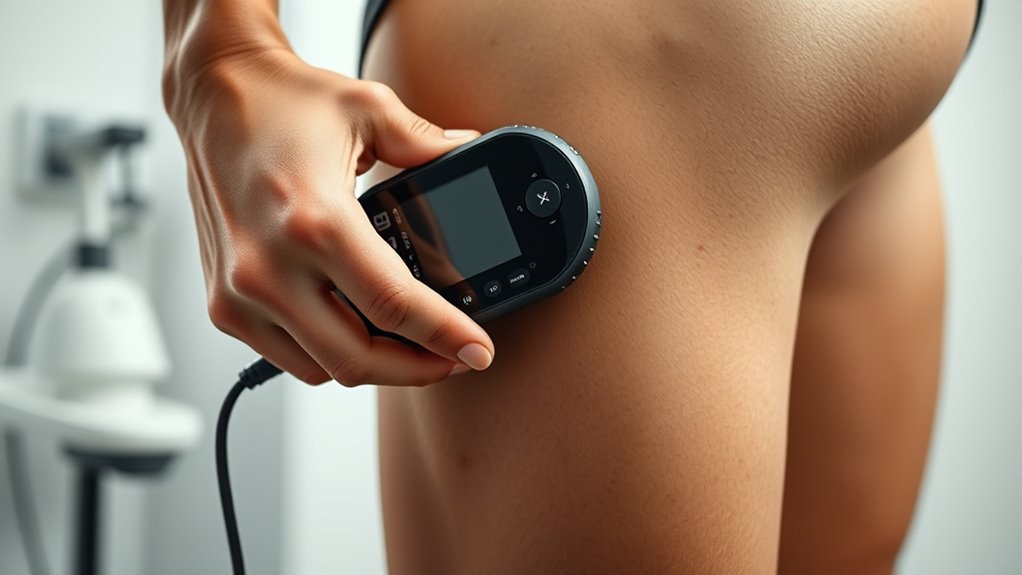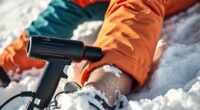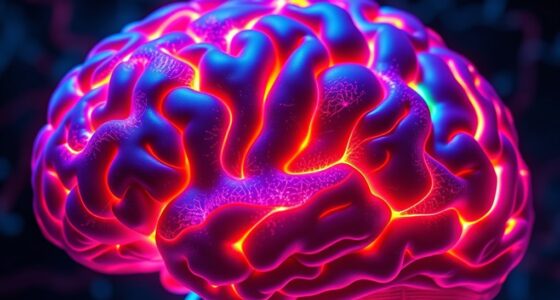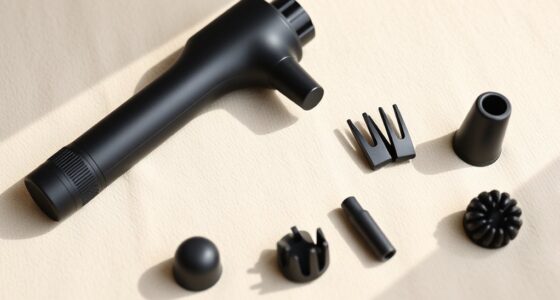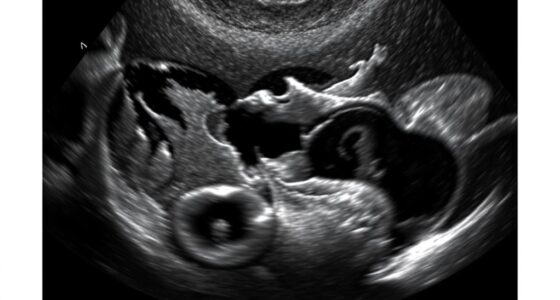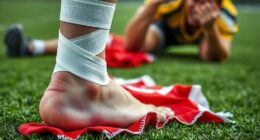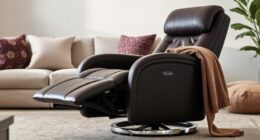Myotonometry is a simple, non-invasive method to measure your muscle stiffness and elasticity. It involves a device that applies a gentle force to your muscle and records how it responds, giving you an objective view of your recovery after DOMS. Monitoring these properties helps you understand if your muscles are ready for activity or need more recovery time. Keep exploring to uncover how this technique can enhance your training and recovery strategies.
Key Takeaways
- Myotonometry is a non-invasive method to measure muscle stiffness and elasticity objectively.
- It uses a device with a probe that applies gentle force and sensors to assess muscle response.
- After DOMS, myotonometry helps evaluate muscle recovery by detecting changes in stiffness.
- Elevated stiffness readings post-DOMS indicate incomplete recovery or muscle tightness.
- This technique guides athletes and clinicians in monitoring muscle readiness and optimizing recovery strategies.
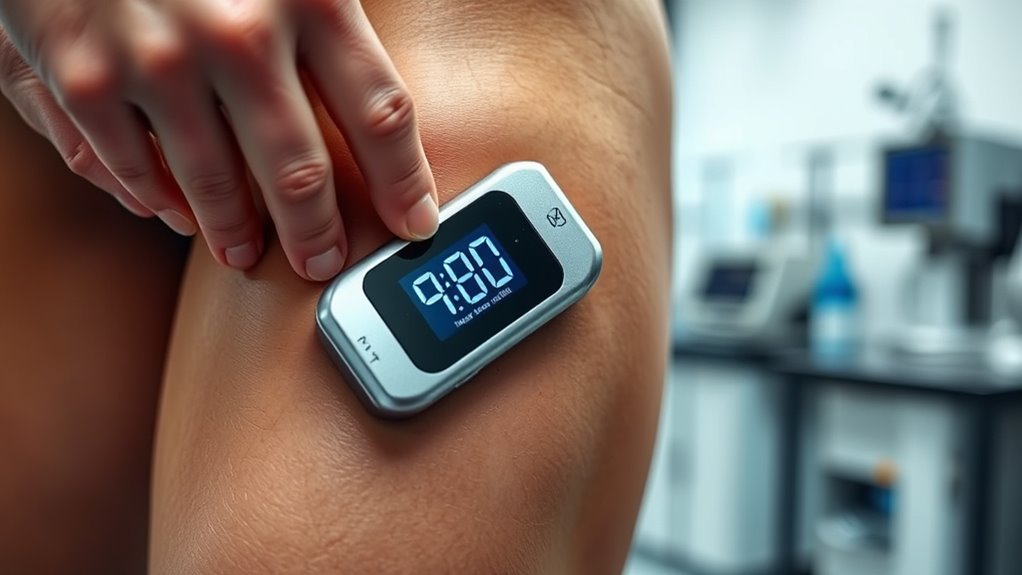
Myotonometry is a non-invasive technique used to measure the mechanical properties of muscles, such as stiffness and elasticity. If you’re recovering from intense exercise or experiencing delayed onset muscle soreness (DOMS), understanding how your muscles respond can be vital. This method allows you to quantify muscle stiffness, giving you an objective way to assess how your muscles are healing and whether they’re ready for your next workout. Unlike other assessment tools, myotonometry doesn’t require invasive procedures or extensive training, making it accessible for both clinicians and athletes alike.
Myotonometry offers a simple, non-invasive way to measure muscle stiffness and monitor recovery effectively.
When you use myotonometry to evaluate muscle stiffness, you get a clear picture of how your muscles are adapting post-exercise. Muscle stiffness is a key indicator of muscle health and recovery; higher stiffness can mean your muscles are tight, potentially increasing injury risk, while lower stiffness might suggest muscle fatigue or over-relaxation. By regularly measuring these properties, you can monitor your recovery process and adjust your training intensity accordingly. This real-time feedback helps prevent overtraining and reduces the chances of injury, ensuring you maintain peak performance levels.
The device itself typically consists of a small probe that applies a gentle, controlled force to your muscle tissue. As it presses into the muscle, sensors measure the muscle’s response—how it resists or yields to the force. These measurements are then translated into data that reflect muscle stiffness and elasticity. The process is quick, painless, and can be performed on various muscle groups, making it ideal for tracking progress over days or weeks. If your muscle stiffness remains elevated after DOMS, it might indicate incomplete recovery, prompting you to rest or incorporate lighter activities until your muscles regain their normal elasticity.
Using myotonometry as part of your recovery assessment enables you to make informed decisions about your training schedule. Instead of relying solely on subjective feelings of soreness or fatigue, you gain objective data that can guide your training intensity, helping you optimize recovery and performance. For athletes, this means avoiding premature return to strenuous activity, which could lead to injury, and for casual exercisers, it offers reassurance that their muscles are healing properly. Over time, tracking these measurements can also reveal patterns, allowing you to tailor your recovery strategies—such as stretching, massage, or active recovery—to better suit your individual needs.
Frequently Asked Questions
Can Myotonometry Predict Muscle Injury Risk?
Yes, myotonometry can help predict muscle injury risk by evaluating muscle stiffness and tone. When you monitor these properties regularly, you can identify areas of increased stiffness that may signal a higher risk of injury. Using this data, you can adjust your training or incorporate targeted recovery strategies, ultimately aiding in injury prevention and keeping your muscles healthier and more resilient during intense activity.
How Does Hydration Affect Myotonometry Readings?
Hydration levels can subtly influence your myotonometry readings, much like a gentle breeze affecting the ripples on a calm lake. When you’re well-hydrated, your muscle elasticity tends to improve, resulting in more accurate measurements. Conversely, dehydration may make muscles less pliable, potentially skewing results. Staying properly hydrated guarantees your readings reflect true muscle properties, helping you monitor recovery and prevent injury with confidence.
Is Myotonometry Suitable for Children or Elderly?
You can use myotonometry for pediatric assessment and evaluating geriatric muscle, but with caution. It’s suitable because it’s non-invasive and quick, helping you monitor muscle tone in children and the elderly. However, consider their specific needs and conditions, as factors like cooperation or muscle fragility may influence accuracy. Always adapt the technique to ensure safe, reliable results in both pediatric and geriatric populations.
What Equipment Is Required for Accurate Measurements?
You need a specialized myotonometry device, a calibration tool, and a comfortable surface for accurate measurements. The device should be calibrated regularly to guarantee precise readings of muscle stiffness. You’ll also require a consistent application technique, a soft probe, and a stable environment. Proper calibration, consistent use, and appropriate equipment allow you to accurately assess muscle stiffness, helping you track changes after DOMS and other muscle conditions effectively.
How Often Should Myotonometry Be Performed After DOMS?
You should perform myotonometry every 24 to 48 hours after DOMS for effective recovery monitoring. This measurement frequency helps you track muscle stiffness and relaxation changes as they occur, giving you valuable insights into your recovery process. Regular assessments ensure you’re not overtraining and allow you to adjust your activity levels accordingly, promoting ideal recovery and preventing further muscle soreness or injury.
Conclusion
So, next time you experience delayed onset muscle soreness, remember that myotonometry offers a quick way to measure your muscle’s stiffness and recovery. Imagine your muscles as a rubber band—after intense exercise, they tighten like a stretched rubber band, reaching stiffness levels that myotonometry can detect. With over 80% accuracy in evaluating muscle properties, this tool helps you track progress and prevent injury, making your recovery smarter and more effective.
